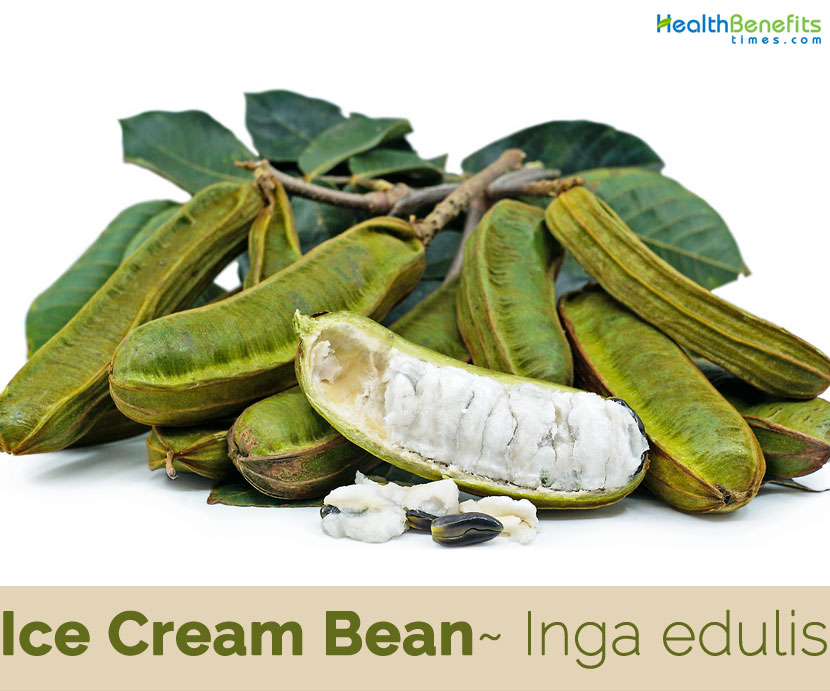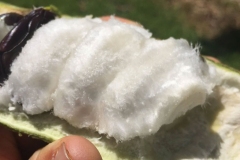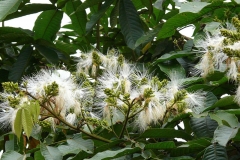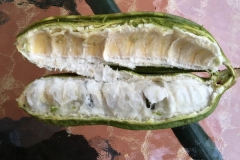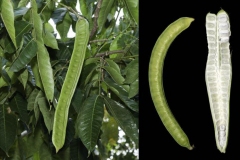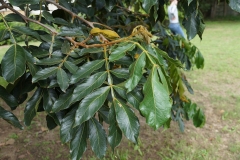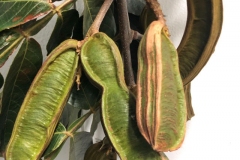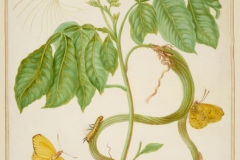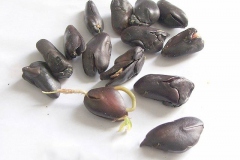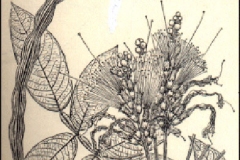It grows in the Inga edulis tree and is extensively used by the indigenous Amazonians for timber, shade, food, medicine, and production of the alcoholic beverage cachiri. It is popular in Peru, Ecuador, Pernambuco-Brazil, Venezuela and Colombia. The edible fruit is very popular in S. America, where it is commonly collected from the wild and also often cultivated. The fruits are often sold in local markets. The tree is also used extensively, especially in Central America, to provide shade in coffee, tea, and cacao plantations, and also around dwellings. The English name is caused by the sweet taste and creamy texture, which resembles ice cream. The scientific name comes from “inga”, as it is known among the Tupí natives.
Ice Cream Beans Facts
| Ice Cream Bean Quick Facts | |
|---|---|
| Name: | Ice Cream Bean |
| Scientific Name: | Inga edulis |
| Origin | Central and south America (Bolivia, brazil, Colombia, Ecuador, French Guiana, Guyana, Peru, Surinam and Venezuela) |
| Colors | Green when young turning to yellowish brown as they mature |
| Shapes | Longitudinally ribbed, cylindrical indehiscent leguminous pods which can be straight, curved or often spirally twisted up |
| Flesh colors | White |
| Taste | Slightly like vanilla ice cream |
| Health benefits | Eyes Health, Helps in weight loss, Muscle Health, Maintain Heart Health, Treats dysentery, High Cholesterol Treatment, Balances Blood Sugar, Make Bones strong, Stay Full Longer, Maintain Body Cells Health, Treats rheumatism, Cures Constipation, Treats headaches, Prevents Cancer, Good for Digestion, Prevents Gas or Flatulence, Treats Dysentery, Mood Enhancer, Removes Toxins, Cures Depression |
| Name | Ice Cream Bean |
|---|---|
| Scientific Name | Inga edulis |
| Native | Central and south America (Bolivia, brazil, Colombia, Ecuador, French Guiana, Guyana, Peru, Surinam and Venezuela) |
| Common Names | Ice cream bean, guaba, inga cipo, guamo bejuro, pois sucre, rabo de mico, inga de metro, monkey tail, Monkey Tamarind |
| Name in Other Languages | Bolivia: Inga de macao Brazil: Abaremotemo, abavemo, engá, inga, inga cipo, inga doce, inga macarrao, inga timbo, ingá-caixao, ingá-cipó, ingá-da-beirada, ingá-da-praia, ingá-doce, ingaí, ingá-opeapiíba, ingá-rabo-de-mico, ingá-timbó, ingá-verdadeira, rabo de mico, rabo-de-mico Colombia: Guama, guamo Costa Rica: Guaba chilillo, monkey tail Ecuador: Barisa pacae, estihua pacae English: Ice-cream bean, Monkey tail, Guaba, Pois Doux, food inga, St. John’s bread French: Pois ice-cream, Pois doux, pacayer, pois sucre German: Essbare Inga, Inga-Früchte Guyana: Waikey Hebrew: שעועית הגלידה Japanese: Inga edo~urisu (インガ・エドゥリス) Maori (Cook Islands): K!kō, pākaiē Persian: اینگا ادالیس Peru: Guabilla, pacae soga, pacay, rujino shimbillo, waupa Portuguese: Anga, Ingá, Ingá-cipó, Ingá de macaco, maIngá de metro, Ingá macarrão, Inga-rabo-de-mico, Ingá de metro, inga doce, Ingá timbó , Ingá vermelho , inga veludo, inga, Caujinquil, Russian: Inga s’edobnaia (Инга съедобная), Struchok-moroxhenoe (Стручок-мороженое), Kremovyy bob (Кремовый боб) Spanish: Chalahuite, Chalaite, Cuajiniquil, Guaba, Guaba de bejuco, Guama, Guamo santafereño, Guamo San Antonio, Guava, Guava machete, Guavo-bejuco, Inga cipo, Jiniquil, Pacae , Pacay , Guaba mecate, Guaba chilillo, Monkey tail Tahitian: Pakai Venezuela: Guama, guamo, guamo liso |
| Plant Growth Habit | Tropical fast growing evergreen tree with a broad, spreading, moderately dense crown |
| Growing Climates | Riverine flood plains, upland woods at edge of rivers, adjacent rainforests, moist, wet, or sometimes rather dry forest, or in open places, thickets and wooded swamps, margins of large rivers |
| Soil | Flourishes in soils of all types within an extended pH range of 4-8. It can handle some waterlogging and short drought periods |
| Plant Size | 30 m (98 ft.) high and 60 cm (2.0 ft.) diameter at breast height usually branching from below 3 m (9.8 ft.). |
| Bark | Grey bark, with pale elongated lenticels |
| Leaf | Alternate, evenly pinnate, 10-30 cm long, with 4 to 6 pairs of opposite dark-green, membranous, slightly pubescent, oval leaflets |
| Flowering season | Feb – May |
| Flower | Flowers are usually fragrant, sessile and pentamerous consisting of a calyx tube with 5 lobes, a corolla tube with 5 lobes and a large number of white stamens |
| Fruit Shape & Size | Longitudinally ribbed, cylindrical indehiscent leguminous pods which can be straight, curved or often spirally twisted up |
| Fruit Color | Green when young turning to yellowish brown as they mature |
| Flesh Color | White |
| Propagation | By seeds |
| Plant Parts Used | Beans, leaves, bark |
| Seed | Ovoid seeds are purplish-black to olive colored |
| Taste | Slightly like vanilla ice cream |
| Life span | Approximately 30 years |
| Health Benefits |
|
Plant Description
Ice Cream Bean is a tropical fast growing evergreen tree with a broad, spreading, moderately dense crown. The plant usually grows up to 20 meters tall, though specimens up to 30 meters have been recorded. The cylindrical bole is often contorted; it can be up to 60 cm in diameter, often branching from near the base. The branches form a broad, flat, moderately dense canopy. It can be evergreen in tropical regions and deciduous when planted in colder regions. The bark is pale grey and smooth, with pale elongated lenticels. The young twigs and stem are angular in cross-section and are covered in fine short brown hair. The plant is found growing in riverine flood plains, upland woods at edge of rivers, adjacent rainforests, moist, wet, or sometimes rather dry forest, or in open places, thickets, wooded swamps and margins of large rivers. The plant flourishes in soils of all types within an extended pH range of 4-8. It can handle some waterlogging and short drought periods.
Leaves
The leaves are alternate, evenly pinnate, 10-30 cm long, with 4 to 6 pairs of opposite dark-green, membranous, slightly pubescent, oval leaflets. The terminal pair of leaflets is larger than the basal pair. The terminal leaflets can grow up to 18 cm long by 11 cm wide in comparison to the basal ones. Between each leaflet there is a nectary gland on the leaf rhachis and these are large (2 to 3 mm) and squashed transversely, an important character for identifying the species. The leaflets and rhachis are covered in dense, short, rough brown hair. The seedlings have a characteristic grayish sheen on the upper leaf surface.
Flower
The inflorescences are dense axillary spikes of flowers, each consisting of a calyx tube with 5 lobes (4 to 9 mm long), a corolla tube with 5 lobes (13 to 25 mm long), and a large number of white stamens up to 4.5 cm long, united in a tube in the lower half. Flowers are usually fragrant, sessile and pentamerous. In humid climates the plant may flower throughout the year, but in regions with a short dry season it is most likely to flower at the beginning of the wet season. Normally flowering takes place between Feb and May. The inflorescences may not have many flowers open at the same time, but they are usually conspicuous.
Fruit
Fertile flowers are followed by longitudinally ribbed, cylindrical indehiscent leguminous pods which can be straight, curved or often spirally twisted up. They are pendant and up to 1 m long and yellowish brown to greenly colored. Inside the pods there are green seeds covered by edible sweet, cottony, creamy pulp, white in color which gives it the name Ice cream bean, since they taste sweet. The amount of ovoid seeds can vary from 10–20, which are purplish-black to olive colored. The fruits become ripe during the wet season in the rainforest. The flesh is very popular among the birds and monkeys in the area, who discard the seeds as they eat it.
History
The Ice Cream bean’s native range ranges from Mexico in the north to the Amazon rainforest in the south. It has since been naturalized in tropic and sub tropic climates throughout the globe. The trees are frost sensitive, but thrive in warm climates where sunshine is plentiful. Due to their fast growing dense canopies, Ice Cream bean trees are often grown to provide natural shade for cacao, coffee, tea and vanilla plants. They also naturally fix nitrogen from the air into the soil, enriching the surrounding earth and benefiting nearby crops.
Health benefits of Ice Cream Bean
Ice Cream Bean is packed with antioxidants, vitamins A, B and C, fiber and protein. Listed below are some of the good reasons why you need to add it to your diet
1. Eyes Health
Ice cream bean consists of good amount of vitamin A compositions which is actually good to maintain the health of eyes. Consuming ice cream bean on a regular basis helps to make your vision clearer and sharper. Your eyes will be not easily suffered from the night blindness or cataract. Carotenoid or beta carotene is natural essence contained in the fruits or vegetable which has red, yellow, or orange color. The function of beta carotene is to convert the color essence of the vegetables and fruits to be vitamin A and therefore being the source of vitamin A.
2. Helps in weight loss
The fruit tastes like vanilla ice cream and is also low in calories. This makes it used as a flavoring agent in various types of desserts by people who are watching their weight or are health conscious. The fruit is also low in cholesterol so it is well suited for those people who already suffer from high cholesterol levels.
3. Muscle Health
Ice cream bean is quite useful for developing body muscle. The most effective way to maximize the benefits of ice cream bean for muscle health is by consuming the beans while doing regular sport. The beans will work to form the mass muscle. In continuous exercise, you will the result immediately.
4. Maintain Heart Health
It is not overstated to say that heart is one of the very essential organs for the human life. Therefore, you need to maintain and keep the organ healthy earlier in order to prevent many diseases attack in the future. Maintaining the healthy life style and diet menu moderation are the easiest way to health your attack and the food you need to consume is ice cream bean.
5. Treats dysentery
Dysentery is bloody diarrhea that is commonly caused by Shigella species or Entamoeba histolytica. Patients suffer loose stools that may contain a lot of red blood. Ice cream bean fruits, seed or bark are considered quite beneficial to treat this issue. There are numerous ways to cook the bark and seeds that can offer relief for people suffering from this condition.
6. High Cholesterol Treatment
Ice cream bean can be used to cure high cholesterol which can lead to multiple horrible diseases. While increasing the portion of ice cream bean, you also need to decrease the consumption of red meat such as beef and lamb. If you do it regularly, your high cholesterol can be instantly reduced.
7. Balances Blood Sugar
Ice cream bean consists of good amount of protein and fiber. Due to its high level of fiber and protein, the work of kidneys to control the blood sugar in the blood is much easier. Higher protein and fiber is also well known as the natural treatment to control the blood sugar. The bean has low level of natural sugar which will not create incline of blood sugar.
8. Make Bones strong
Ice cream bean is a good source of calcium and mineral compositions which helps to strengthen the bones and makes them stronger and healthier. Thus several scientific researchers have recommended consuming the bean in order to prevent the osteoporosis of the bones.
9. Stay Full Longer
Consuming ice cream bean will make you feel full longer without easily get hungry anymore. This is due to the ability of the beans to prevent the excessive appetite. It surely will benefit you if you are in diet mode. The beans can make you full and health as well.
10. Maintain Body Cells Health
The natural composition of the beans will get into the body cells and prevent from the broken and destroyed cells due to bacteria attack or free radical. This also results stronger protection from cancer cells growth.
11. Treats rheumatism
Rheumatism is a disease caused by inflammation and pain to the joins or muscles. Tropical fruits like Ice cream bean consist of huge amount of anti-inflammatory properties, which helps to keep the bones strong and offer relief from pain. You may also consume the bark and seeds as a preventive measure and avoid developing the disease altogether.
12. Cures Constipation
Ice cream bean is considered one of the wonderful anti-constipation foods. The bean is really good to smooth the digest system and make your digest organ healthier so that you can get rid of constipation.
13. Treats headaches
If you suffer from headaches, consume a good amount of these fruits as it contains a lot of healing properties. Those suffering from depression and anxiety mainly should include these fruit into their diet. It contains antioxidants that help produce the ‘feel good’ hormones and prevent depression symptoms.
14. Prevents Cancer
Ice Cream Bean fruits consists of compounds like flavonol quercetin, gallic acid and epicatechin which are anti-cancer. Including these fruits in your regular diet helps to reduce the risks of cancer.
15. Good for Digestion
Ice cream bean fruits help in digestion with the presence of trypsin and chymotrypsin which work to convert proteins into amino acids. Thus, nutritional benefit of foods is easily extracted.
16. Prevents Gas or Flatulence
Ice cream bean consists of good amount of chymotrypsin, due to which all risks of gas or flatulence is reduced. Consuming these on a regular basis helps in getting rid of chronic gas problems.
17. Treats Dysentery
The seeds of the fruit are highly nutritious. They work as an excellent health remedy for people suffering from dysentery. The seeds can be extracted, cooked and should be consumed to deal with dysentery.
18. Mood Enhancer
Consuming the fruit on a regular basis helps in reducing stress and anxiety being rich in antioxidants. It brings about positivity and high energy.
19. Removes Toxins
Ice Cream bean fruits help in removing toxins from the body with its antioxidant properties. Similarly having 8 glasses of water throughout the day helps in removing toxins easily.
20. Cures Depression
Ice Cream bean fruits are highly recommended for people suffering from anxiety. Antioxidants present in this fruit helps in secretion of ‘feel good’ hormones which help in curing depression in the long run.
Traditional uses and benefits of Ice Cream Bean
- Decoction of the crushed leaves is taken to relieve coughing.
- Decoction of the leaves is applied to sores of the lips.
- Arils are used to prepare an alcoholic beverage called cachiri for a festival of the same name in Colombia.
- Native women chew the arils and spit the mixture into a vat, where it is left to ferment.
- Decoction of the leaves, bark or root commonly are utilized as treatments for diarrhea, arthritis and rheumatism.
- Crushed, boiled leaves are consumed to relieve coughing or applied to lip sores, possibly caused by herpes.
- Leaves help to cure headaches and nerve problem.
- Root decoction can be enhanced with pomegranate rind, and then used to cure cases of diarrhea and dysentery.
- Dropsy and digestive problems can be treated with the bark and the fruit.
- Bark and fruit are used for irritations of the raucous lining of the intestines.
- Cuna Indians used the plant as a nervine for headaches.
Other Facts
- It is commonly planted as a shade tree in coffee and cacao plantations.
- It is used for making packing cases, and especially for making piles.
- The wood is used for fuel.
- A popular source of firewood, the wood has a high calorific value and burns with little smoke.
- Cuttings and leaves are also used as mulch and animal fodder
References:
https://www.itis.gov/servlet/SingleRpt/SingleRpt?search_topic=TSN&search_value=506320#null
http://www.hear.org/pier/species/inga_edulis.htm
https://pfaf.org/user/Plant.aspx?LatinName=Inga+edulis
https://plants.usda.gov/core/profile?symbol=INED
https://en.wikipedia.org/wiki/Inga_edulis
https://npgsweb.ars-grin.gov/gringlobal/taxonomydetail.aspx?id=20082
http://tropical.theferns.info/viewtropical.php?id=Inga+edulis
https://www.cabi.org/isc/datasheet/28656
https://tropilab.com/inga.html
http://florawww.eeb.uconn.edu/198500714.html
http://www.theplantlist.org/tpl1.1/record/ild-221
https://davesgarden.com/guides/pf/go/62834/#b
https://gd.eppo.int/taxon/INGED
https://www.hort.purdue.edu/newcrop/duke_energy/Inga_edulis.html


